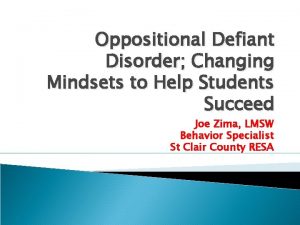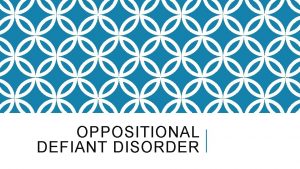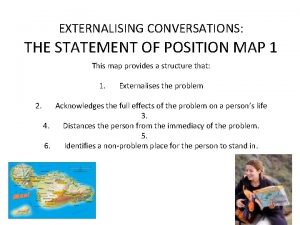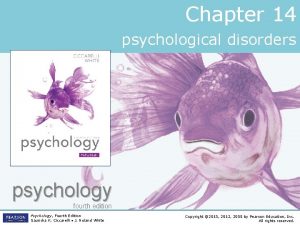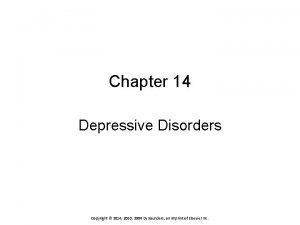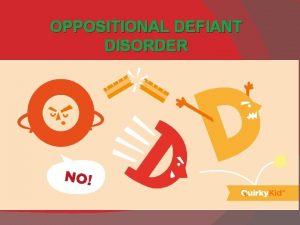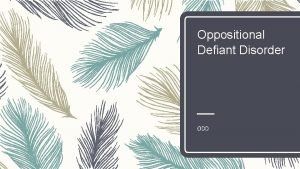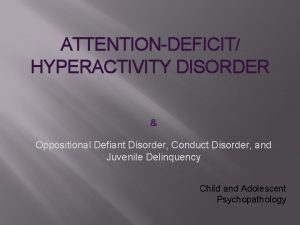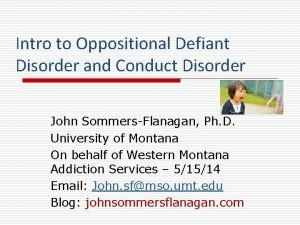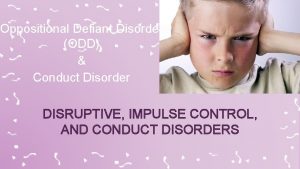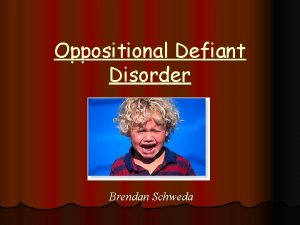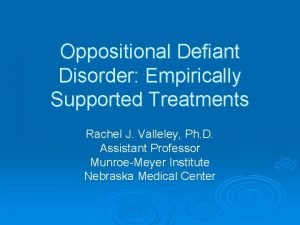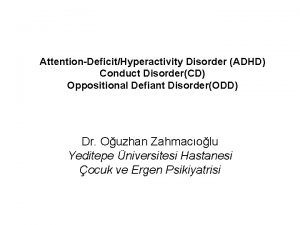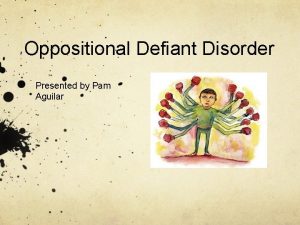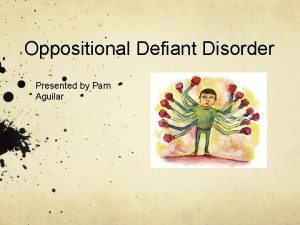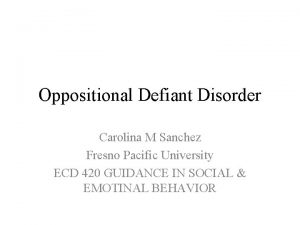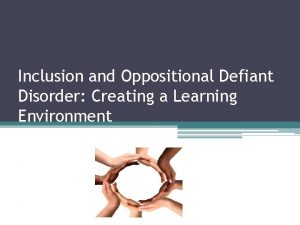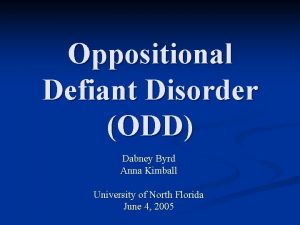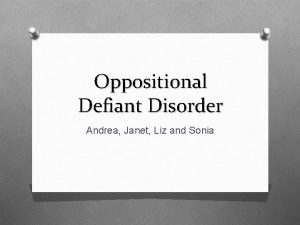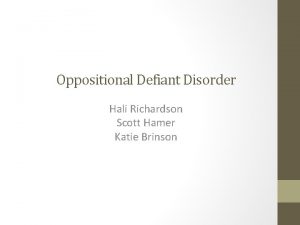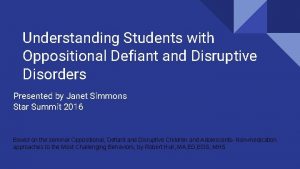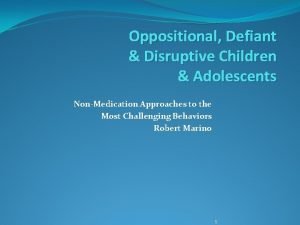EXTERNALISING DISORDERS Chapter D 2 OPPOSITIONAL DEFIANT DISORDER























- Slides: 23

EXTERNALISING DISORDERS Chapter D. 2 OPPOSITIONAL DEFIANT DISORDER Katie Quy & Argyris Stringaris DEPRESSION IN CHILDREN AND ADOLESCENTS Companion Power. Point Presentation Adapted by Julie Chilton

The “IACAPAP Textbook of Child and Adolescent Mental Health” is available at the IACAPAP website http: //iacapap. org/iacapap-textbook-of-child-and-adolescentmental-health Please note that this book and its companion powerpoint are: · Free and no registration is required to read or download it · This is an open-access publication under the Creative Commons Attribution Noncommercial License. According to this, use, distribution and reproduction in any medium are allowed without prior permission provided the original work is properly cited and the use is non-commercial.

Oppositional Defiant Disorder Outline • • • The Basics Diagnosis Epidemiology Aetiology & risk factors Assessment Treatment

Oppositional Defiant Disorder The Basics • “A persistent pattern of defiant, disobedient, and antagonistic behavior toward adults” • No antisocial or aggressive acts like the ones found in conduct disorder • Common • Substantial impairment • Poorer adjustment outcomes • Increased cost to society

Oppositional Defiant Disorder Diagnosis • DSM-5: 4 or more of the following, not just with siblings, lasting greater than 6 months – – – – Often loses temper Often touchy or easily annoyed Often angry and resentful Often argumentative with adults/authority figures Often defies or doesn’t follow rules Often deliberately annoys others Often blames others Spiteful or vindictive 2 x in 6 months • ICD-10: persistent pattern of provocative, hostile and non-compliant behavior, with low temper threshold

Oppositional Defiant Disorder Epidemiology • • Prevalence: 2 -10% Boys>girls Symptoms decline after age 10 Rarely diagnosed in older children Estimates vary across countries Majority do not develop conduct disorder High rates of comorbidities

Oppositional Defiant Disorder Epidemiology

Oppositional Defiant Disorder Epidemiology

Oppositional Defiant Disorder Comorbidity

Oppositional Defiant Disorder Aetiology & Risk Factors • • • Genetics Gene-environment interplay Earlier age of onset of antisocial symptoms Different temperamental routes Rejection by non-deviant peers Callous and unemotional traits Social and economic disadvantage Neighborhood violence Negative parenting “Coercive family processes”

Oppositional Defiant Disorder Parental Influence: “coercive family processes” • Parents of children with disruptive behavior problems are more likely to be inconsistent in how they apply rules, and give commands that are either unclear or the result of their own current emotional state rather than contingent upon the child’s behavior Gerald R Patterson Founder of the Oregon Social Learning Centre

Oppositional Defiant Disorder Assessment • • • Gather information from multiple sources Assess comorbidities Consider family, school and neighborhood Watch for bullying or peer deviance Assess for learning difficulties

Oppositional Defiant Disorder Differential Diagnosis • • • Phobias Other anxiety disorders Obsessive Compulsive Disorder ADHD Autism Depression



Oppositional Defiant Disorder Treatment • Identify and treat comorbidities • Address modifiable risks • Parent management training (see Chapter A. 12) – The Incredible Years – Triple P (Positive Parenting Program) • • Alternative approaches School-based interventions Individual therapy (anger management) Medication

Oppositional Defiant Disorder Treatment Goals Parents: • Improve positive parenting skills • Enhance problem solving, conflict resolution, communication skills Child: • Develop effective communication, problem-solving and anger management skills Family: • Family counseling and support Classroom: • Social skills sessions from teacher or counselor

Oppositional Defiant Disorder Treatment: The Incredible Years • For parents, teachers, and children • 3 programs: basic, advanced, partners • Basic: – – – 13 -16 2 hour weekly sessions Videos of right vs wrong child management Topics: play, praise, rewards, limit-setting, handling misbehavior Discussions after with rehearsal Homework Telephone support • Multi-center controlled trial in 141 children age 3 -8 with antisocial behavior utilizing Basic programme – Decrease in antisocial behavior, hyperactivity, total number of problems per day, conduct problems, total deviance (SDQ), externalizing and total problem scores (CBCL), parent defined problems, and ICD 10 diagnoses of ODD – Decrease in parents’ inappropriate commands

Oppositional Defiant Disorder Treatment: Triple P–Positive Parenting Program Multiple levels: • Information on parenting issues for interested parents • Advice for specific problem behaviors • Brief programs for advice/training with minor behavioral problems • More intensive programs for persistent and pervasive behavioral problems – mood management strategies – Coping skills – Partner support skills

Oppositional Defiant Disorder Treatment: School-Based Interventions Tools for teachers in 4 Primary Domains: • Promoting compliance and adherence to classroom rules and acceptable behaviors • Developing problem solving skills • Preventing problem behavior • Avoiding escalation of oppositional behavior

Oppositional Defiant Disorder Treatment: Individual therapy—Anger Management • CBT-based • Coping skills approach with stress inoculation • 3 elements: – Cognitive preparation – Skill acquisition – Application training • Role play

Oppositional Defiant Disorder Treatment: Medication • No evidence for medication in ODD alone • Stimulants improve conduct and oppositional symptoms in ADHD • Sodium valproate may help with aggression in hospitalized children with ADHD if stimulants failed • No effects on severe irritability with Lithium • Evidence lacking for use of SSRI’s for anger in children • Anti-manic agents should not be given for ODD only • Dopamine antagonists: use short-term on a case by case basis

Oppositional Defiant Disorder Thank You!
 Odd diagnostic criteria
Odd diagnostic criteria Oppositional defiant disorder in adults
Oppositional defiant disorder in adults The oppositional gaze black female spectators
The oppositional gaze black female spectators Oppositional defiant disorder
Oppositional defiant disorder Statement of position map 2
Statement of position map 2 Dereflection technique
Dereflection technique Factitious disorder vs somatic symptom disorder
Factitious disorder vs somatic symptom disorder Oppositional gaze bell hooks summary
Oppositional gaze bell hooks summary Oppositional reading media example
Oppositional reading media example Chapter 18 psychological disorders review worksheet
Chapter 18 psychological disorders review worksheet Chapter 11 genetic disorders concept mapping
Chapter 11 genetic disorders concept mapping Chapter 8 skin disorders and diseases
Chapter 8 skin disorders and diseases Chapter 6 musculoskeletal system diseases and disorders
Chapter 6 musculoskeletal system diseases and disorders Chapter 46 digestive and endocrine disorders
Chapter 46 digestive and endocrine disorders Somatic symptom disorder
Somatic symptom disorder Chapter 29 endocrine and metabolic disorders
Chapter 29 endocrine and metabolic disorders Chapter 21 mental health diseases and disorders
Chapter 21 mental health diseases and disorders Chapter 18 psychological disorders
Chapter 18 psychological disorders Chapter 18 eating and feeding disorders
Chapter 18 eating and feeding disorders Chapter 17 reproductive system diseases and disorders
Chapter 17 reproductive system diseases and disorders Chapter 15 nervous system diseases and disorders
Chapter 15 nervous system diseases and disorders Chapter 15 anxiety and obsessive-compulsive disorders
Chapter 15 anxiety and obsessive-compulsive disorders Chapter 14 psychological disorders
Chapter 14 psychological disorders Chapter 14 depressive disorders
Chapter 14 depressive disorders
